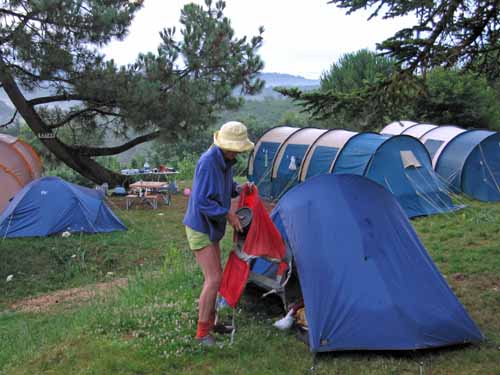
Tuesday, 17 July 2007
Distance 38 km
Duration 7 hours 15 minutes
Ascent 454 m, descent 491 m
Map 57 of the TOP100 blue series (now superseded)
It is a remarkable thing how much it rains in France during the summer, and how seldom we get wet. Most of the rain obligingly falls at night, as it had this time.
Everything was sodden but we found a stone wall near the bar to set out our breakfast. The stag beetle that had been clinging to my pillow last night before I flicked it out into the dark, was now in the bag containing our bowls and spoons. Once again I gave it the flick, and this time it dug itself at a dignified pace into the gravel path.
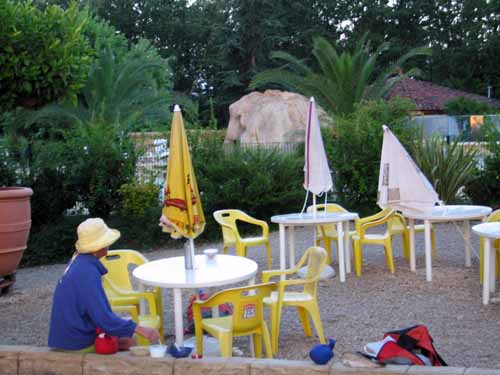
To rejoin the road we did not have to retrace our steps, as there was a dirt track going in the right direction. Once on the D28 we continued through the deep woods and soon came to an intersection with the GR652.
We must have crossed this road in 2003, when we walked on the Rocamadour variant of the main pilgrimage, but neither of us could remember the place. Descending to the highway through more open country, we turned right and after a kilometre or two beside a tumbling stream, took another small road to the left (actually still the D28).
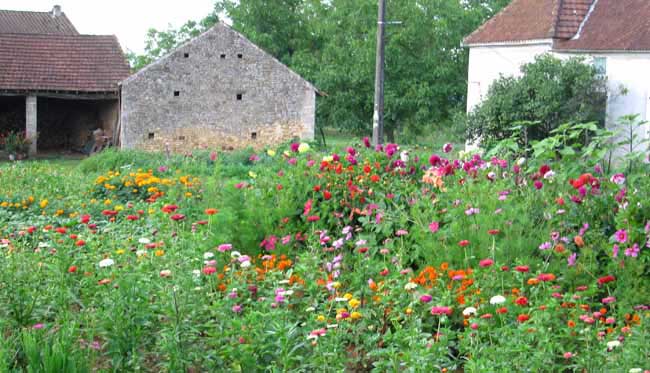
After the initial pull up through forest, most of the land was cleared for crops. We came to a Ferme-Auberge along the way, where we saw people setting tables, so we went in to enquire about coffee, but were quickly sent packing.
This was the exception that proved the rule that the French are a particularly polite and hospitable people.
The rest of the way to Villefranche-du-Périgord was uneventful, except administratively. We changed departments, from Lot to Dorgogne, and at the same time crossed from the region of Midi-Pyrenées to that of Aquitaine.
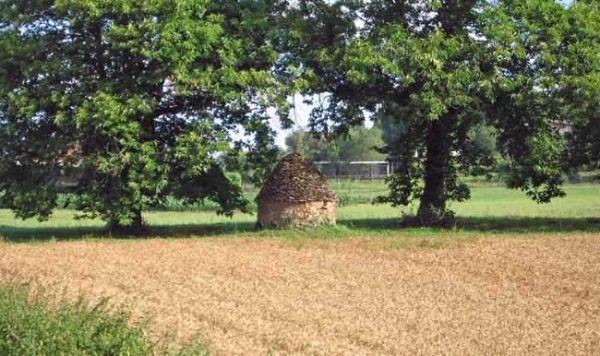
Not only that, but we entered the part of France called Périgord Noir, to distinguish it from the other Périgords – White, Green and Purple. These are old, pre-revolutionary names, but still much used, like Quercy or Gascony.
The hardest part of the walk was the little climb into the town. We found ourselves in a square with a pole at the centre and strings of paper rosettes radiating from it.
We were at the top of a long ridge, and all the streets stretching down were similarly adorned. The villagers must have been busy for weeks getting it all ready, we assumed for Bastille Day.
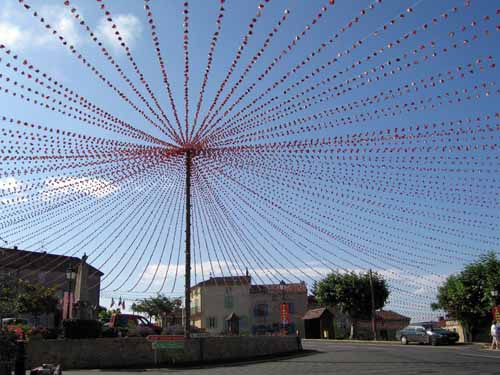
We sauntered down under the streamers towards the square. It was a thirteenth-century new town, a bastide, with the typical arcaded market square and rectangular layout, albeit rather elongated in this case.
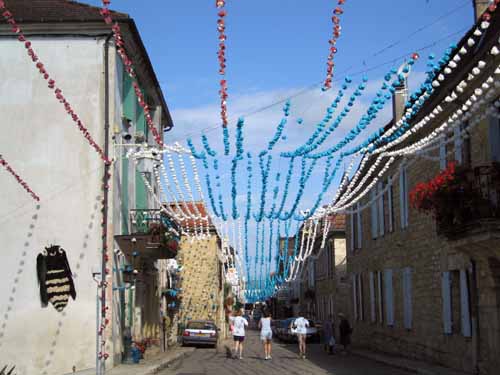
It was 10 o’clock and time for coffee, but first we asked at the Office of Tourism about the prospects for camping at Montpazier, as we thought it was too early to stop here.
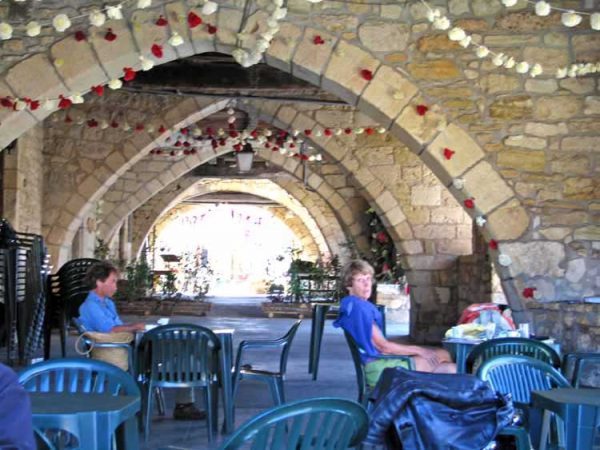
We had walked 16 km and it was a good deal further than that to Montpazier, but we felt strong and, although there was a singular lack of GRs in the district, we had seen a tiny road on the map going in the right direction.
The news about camping was not good. Although there were four camping grounds listed at Montpazier, the nearest was four kilometres out of the village. On the other hand, there were a couple of hotels that we could hope to stay at.
To build up our reserves, we had leisurely coffee and croissants under the arcades, and this was enough to propel us the first five kilometres along the highway, to Saint-Cernin, where our little road turned off.
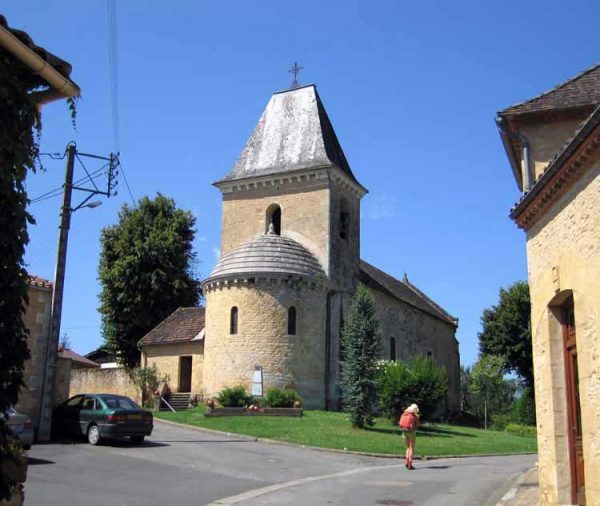
We climbed past the church and a few houses, into a quiet rural landscape. The road was level until a sudden sharp pull up to the village of Fontanilles with its imposing church.
As it was 12:30 and getting hot, we stopped for lunch on a bench in the shade of the church. A travelling grocer’s van drew up near us and women came out from the houses around to chat and laugh while they bought supplies.
We set off again, conscious of how far we still had to go. As before, the road was empty of cars except for an occasional local one, and after a while we turned off our tiny road onto an even tinier one servicing a few farms.
Our water was running low and Keith was slowing down, worried about his kidney stone misbehaving if he got dehydrated.
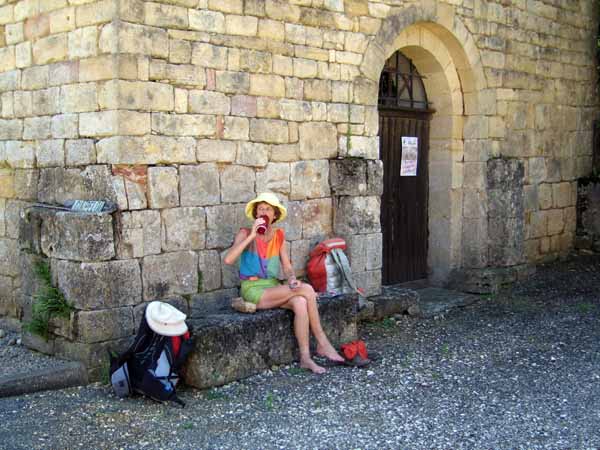
At last we plunged into a wood and descended towards the river, but instead of crossing the bridge to the highway, we turned left along the riverbank, hoping to get to Montpazier by a back route.
We soon began to wonder whether it was such a good idea – the highway was rising on the other side and there was no sign of a second bridge.
With flagging steps we turned onto a track and found ourselves in a private garden, where an old crippled woman and her retarded adult daughter were sitting shelling peas.
They assured us we could cross the river at the sewage works, just down the road, and having done that, we scrambled up a stony wheel track and emerged onto a road coming in from the west.
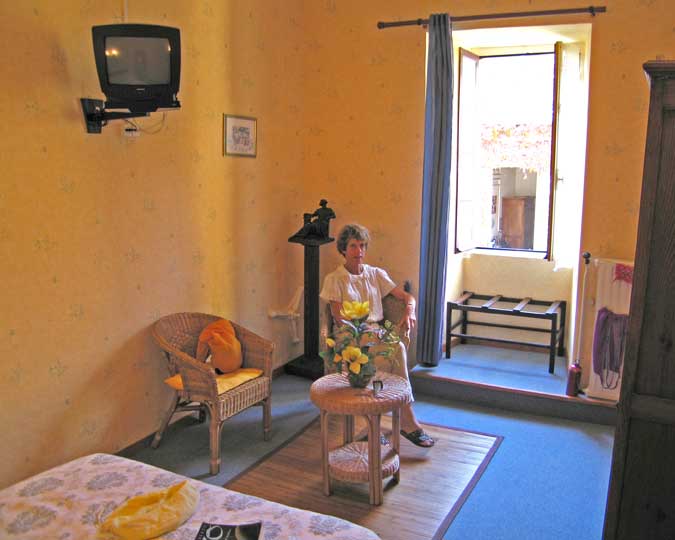
A hundred metres further on we obeyed a sign pointing to “Centre Ville” and saw the arcades of the bastide square at the end of the street, with café umbrellas beckoning.
A great quantity of water and two cups of coffee later, we were ready to think about the night’s accommodation.
The Office of Tourism was closed until 4:30 (it was only 3:30), but we noticed a hotel right on the square, the Hotel de France, which actually owned the bar/restaurant that we were sitting at.
We saw that they only had three double rooms, so without waiting we went in and, to our great relief, got one of them, the only condition being that we eat at their restaurant in the evening.
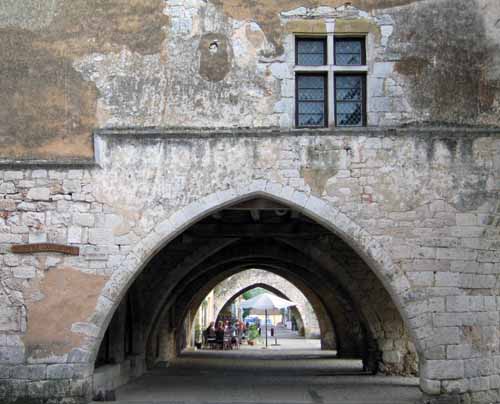
The room was on the second floor and looked onto the square. It had been pleasantly renovated a couple of years earlier, with sprigged yellow wallpaper and a long blue curtain.
After our ablutions in the large, sparkling bathroom, we lay in bed and watched the last hour of the Tour de France on the television above our heads, feeling like royalty.
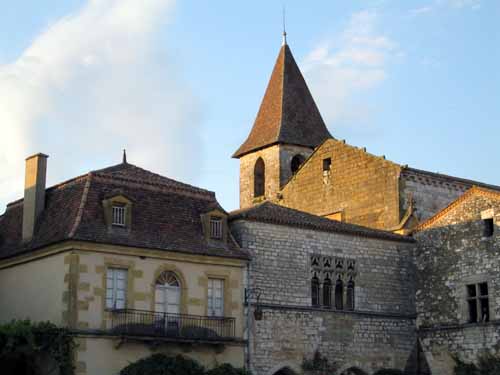
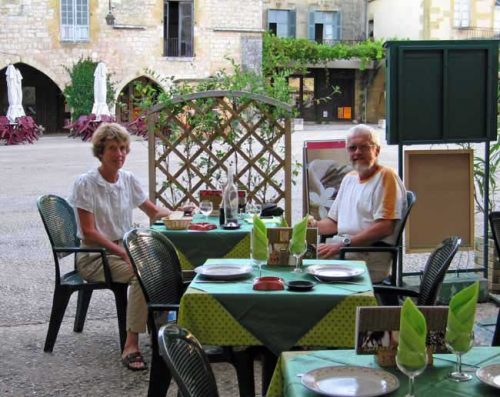
At 8 o’clock we descended the ancient timber staircase in our evening clothes, to have apéritifs in the square. The evening was warm and there were plenty of people eating at the two restaurants.
Montpazier would have to be the best-preserved, most beautiful bastide in France – certainly it was the best we had ever seen. Apart from its own charms, there were no cars allowed in the central square, which greatly improved the ambience.

We began our meal with the habitual salad, then Keith had lamb with pasta and I had duck pie baked in a circular dish.
Both were delightful and so was the feeling that we had only a few steps to walk to get back to our luxurious room.
As we drifted off to sleep we could still hear the convivial babble of the last diners below.
Previous day: Albas to Puy l’Évêque